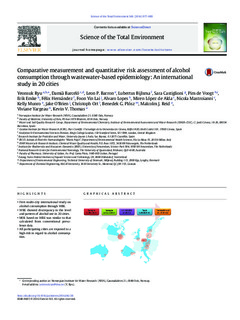| dc.contributor.author | Ryu, Yeonsuk | |
| dc.contributor.author | Barceló, Damia | |
| dc.contributor.author | Barron, Leon P. | |
| dc.contributor.author | Bijlsma, Lubertus | |
| dc.contributor.author | Castiglioni, Sara | |
| dc.contributor.author | de Voogt, Pim | |
| dc.contributor.author | Emke, Erik | |
| dc.contributor.author | Hernández, Félix | |
| dc.contributor.author | Lai, Foon Yin | |
| dc.contributor.author | Lopes, Alvaro | |
| dc.contributor.author | de Alda, Miren López | |
| dc.contributor.author | Mastroianni, Nicola | |
| dc.contributor.author | Munro, Kelly | |
| dc.contributor.author | O'Brien, Jake | |
| dc.contributor.author | Ort, Christoph | |
| dc.contributor.author | Plosz, Benedek | |
| dc.contributor.author | Reid, Malcolm J | |
| dc.contributor.author | Yargeau, Viviane | |
| dc.contributor.author | Thomas, Kevin V | |
| dc.date.accessioned | 2018-10-04T07:02:27Z | |
| dc.date.available | 2018-10-04T07:02:27Z | |
| dc.date.created | 2016-08-30T12:27:43Z | |
| dc.date.issued | 2016 | |
| dc.identifier.citation | Science of the Total Environment. 2016, 565, 977-983. | nb_NO |
| dc.identifier.issn | 0048-9697 | |
| dc.identifier.uri | http://hdl.handle.net/11250/2566271 | |
| dc.description.abstract | Quantitative measurement of drug consumption biomarkers in wastewater can provide objective information on community drug use patterns and trends. This study presents the measurement of alcohol consumption in 20 cities across 11 countries through the use of wastewater-based epidemiology (WBE), and reports the application of these data for the risk assessment of alcohol on a population scale using the margin of exposure (MOE) approach. Raw 24-h composite wastewater samples were collected over a one-week period from 20 cities following a common protocol. For each sample a specific and stable alcohol consumption biomarker, ethyl sulfate (EtS) was determined by liquid chromatography coupled to tandem mass spectrometry. The EtS concentrations were used for estimation of per capita alcohol consumption in each city, which was further compared with international reports and applied for risk assessment by MOE. The average per capita consumption in 20 cities ranged between 6.4 and 44.3 L/day/1000 inhabitants. An increase in alcohol consumption during the weekend occurred in all cities, however the level of this increase was found to differ. In contrast to conventional data (sales statistics and interviews), WBE revealed geographical differences in the level and pattern of actual alcohol consumption at an inter-city level. All the sampled cities were in the “high risk” category (MOE < 10) and the average MOE for the whole population studied was 2.5. These results allowed direct comparisons of alcohol consumption levels, patterns and risks among the cities. This study shows that WBE can provide timely and complementary information on alcohol use and alcohol associated risks in terms of exposure at the community level. | nb_NO |
| dc.language.iso | eng | nb_NO |
| dc.publisher | Elsevier | nb_NO |
| dc.rights | Navngivelse 4.0 Internasjonal | * |
| dc.rights.uri | http://creativecommons.org/licenses/by/4.0/deed.no | * |
| dc.title | Comparative measurement and quantitative risk assessment of alcohol consumption through wastewater-based epidemiology: An international study in 20 cities | nb_NO |
| dc.type | Journal article | nb_NO |
| dc.type | Peer reviewed | nb_NO |
| dc.description.version | publishedVersion | nb_NO |
| dc.rights.holder | © 2016 Elsevier B.V. All rights reserved. | nb_NO |
| dc.source.pagenumber | 977-983 | nb_NO |
| dc.source.volume | 565 | nb_NO |
| dc.source.journal | Science of the Total Environment | nb_NO |
| dc.identifier.doi | 10.1016/j.scitotenv.2016.04.138 | |
| dc.identifier.cristin | 1376631 | |
| dc.relation.project | EC/FP7/317205 | nb_NO |
| cristin.unitcode | 7464,30,21,0 | |
| cristin.unitcode | 7464,20,13,0 | |
| cristin.unitname | Miljøkjemi | |
| cristin.unitname | Økotoksikologi | |
| cristin.ispublished | true | |
| cristin.fulltext | original | |
| cristin.qualitycode | 2 | |

